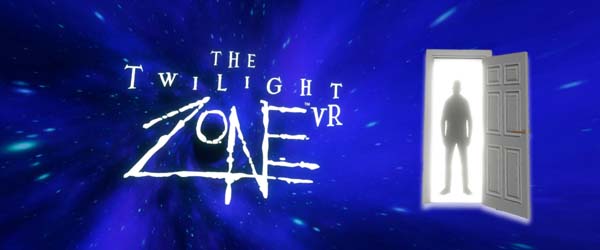
I like the original The Twilight Zone TV show. I wouldn't call myself a huge mega fan or anything, but it's easily my second favorite show from the 60's. Heck, The Twilight Zone might even hold up better than the majority of original Star Trek episodes, and the show is probably more progressive too. For one thing, it isn't loaded with as much of the casual sexism and fetishization of women that keeps popping up in Star Trek.
In any case, the PSVR2 release of a Twilight Zone game kind of came out of nowhere. I saw a preview of it on my Google news feed on my phone the day before the game went on sale on PSN. Heck, the PSN didn't even have it listed as "coming soon". It didn't even show up in the store until it was released, and I immediately jumped on it and bought it.
The game is a small anthology of 3 short, original Twilight Zone stories with some contemporary themes. I was glad to see the game divided up into multiple chapters, and for these chapters to apparently be playable in any order (even though I opted to play them in order anyway). The Twilight Zone really works better as short stories like this, as the premises and twists rarely (if ever) hold up for longer stories. In fact, trying to pad some of its stories into an hour runtime or longer was one of the biggest problems with CBS and Jordan Peele's recent reboot.
You are about to enter The Twilight Zone.
As a tiny nitpick, I will say that I don't understand why Pocket Money chose to use the term "chapters" instead of "episodes"? The use of the word "chapter" implies a small section of a larger story, with that small section not being a story in itself; while the word "episode" would imply self-contained stories that may relate to or follow one another, but which have their own beginning, middle, and end that does not necessarily depend on the other episodes. Yes, all 3 chapters do refer to one another, and seem to take place in the same continuity, and one of them kind of acts as a prequel to another. Regardless of those connections, each chapter is a completely independent, self-contained story that does not at all rely on the events of the other chapters in order to understand what is happening. You can play these chapters in any order, or play any one of them without playing the others, and it wouldn't make any difference to the perception or interpretation of the stories. And in fact, the game is perfectly willing to let the player play them in any order.
Each of this game's chapters takes about 30 minutes to an hour to play, and the whole game should be playable in 2 hours (give or take). Any of the chapters may take longer depending on how many times you might have to repeat some of its more tedious stealth or shooting sections. So these little VR stories hit the sweet spot in terms of length, and they don't over-complicate their gameplay such that it distracts from the story being told. In terms of story-telling, Pocket Money Games puts up a really solid product here. The actual game, however, is a lot less solid. [More]
a711b255-3f32-4e5e-b356-482f206f06b9|8|4.0
Tags:The Twilight Zone, The Twilight Zone VR, PSVR2, virtual reality, horror, science fiction, Pocket Money Games, Fun Train, Rod Serling, Kiff VandenHeuvel, corporate culture, crunch, video game, post-apocalypse, alien, abduction
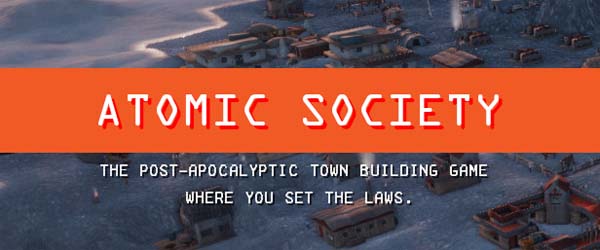
After going back and revisiting Cities Skylines for its Airports expansion and being thoroughly underwhelmed, I decided to did into my Steam backlog for some other lightweight city-builders. Far Road Games' Atomic Society had just left early access in August of 2021, so I went ahead and downloaded it to give it a try. And I was underwhelmed again.
Atomic Society just doesn't have enough content to keep me playing for very long, and the content that it does have is not nearly as engaging as I would like for it to be. It is a town-builder with a post-apocalyptic theme that seems to be heavily inspired by Fallout (possibly by Fallout 4's settlement customization mechanics). In fact, despite being a town-builder, Atomic Society requires the player to create an avatar character whose backstory is that they had emerged from a fallout shelter and is attempting to lead a band of wasteland survivors to a new home. So yeah, it's basically what you get if you imagined Fallout 4's settlement management in the form of a top-down city-builder instead of a first-person shooter. Sounds good on paper, but Atomic Society is far from the best possible take on the subject matter.
Imagine the settlement-building of Fallout 4 ... but without any of the personality.
Wandering alone
New buildings are few and far between. Because this is a post-apocalyptic game with very scarce resources and population, the total number of structures that need to be built is relatively small (though multiple copies of many basic buildings are required, and I'll be talking about that soon). As such, most of the actual game consists of micro-managing the Town Leader. This Town Leader is usually the one who has to build new structures by hand, and who has to go in and salvage materials from ruined structures and vehicles.
In fact, micro-managing this one character is so critical to keeping your town running, that the SPACEBAR (of all buttons!) is assigned the sole function of automatically selecting and centering the camera on the Town Leader. Usually, I would expect the spacebar in a town-building game to do things like pause or unpause the simulation, or to bring up the build menu or some other important management menu. Nope. In Atomic Society, the most important button on the keyboard is for selecting the Town Leader.
The Town Leader will be doing most of the scavenging, building, and repairing.
Micro-managing the Leader wouldn't be so annoying and tedious if the U.X. for managing him were a bit better. For instance, it would be nice to have a widget in the corner of the screen somewhere that shows what the Town Leader is doing at all times, and a small overview of his current inventory. There's not even a mini-map or hotkeys to quickly navigate to important locations on the map. It would also be really nice if the player could queue up actions for the Leader. Without being able to put multiple actions in a queue, I am stuck having to pause the game every few minutes to check on what he is doing and manually assign him to his next task. I'm constantly stopping the game to tell him to run to a salvage site, then back to a stockpile to drop off the materials, then out to build some building, then somewhere else to repair some building before it collapses, then back out to another salvage site.
All this babysitting gets very tedious, very quickly. Worse yet, when it does come time to actually build things, the need to manage the Town Leader can often get in the way and disrupt the flow of settlement-planning.
It doesn't help that path-finding is completely broken. I'll tell him to go to a ruin site or to deposit his inventory in the nearest storehouse, and he'll circumnavigate the entire map to get there instead of taking a direct route. Or he'll pass by right by a storehouse to get to a different one further away. And if I want him to go to a specific nearby storehouse that he refuses to path to on his own, the only alternative for me is to take manual control and walk him across the map myself using the W,A,S,D keys. It's just miserable. [More]
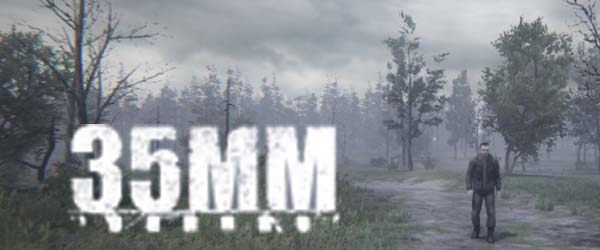
December, January, and February is usually a time when I try to make a dent in my ever-growing Steam backlog. I buy lots of games on Steam sales, and then end up not playing most of them. So when I do go into the backlog, I always try to emphasize some of the shorter, indie games in the hopes that I can power through several before the big spring game releases start rolling in. This time around, I loaded up an independent Russian game from developer Sergey Noskov, which was very well-reviewed back when I bought it in 2016. Apparently, it's going to be released on PS4 soon, so this review is sort of topical. It hasn't really held up as well as I hoped it would in the almost-5 years since its release.
Ironically, this game is set during a fictional ebola pandemic that has turned Russia into a post-apocalyptic wasteland, and I'm playing it during the ongoing COVID-19 pandemic. The game was released back in 2016, long before COVID.
35mm is a hard game to classify. It's not quite a shooter. Not quite a survival game. Not quite a horror game. And not quite a walking simulator. It straddles the line between all of these sub-genres, shifting from one to the other at the drop of a hat, but without ever feeling jarring about it. There's even a few little mini-games thrown in for good measure. As such, there's plenty of variety that helps prevent this game from ever feeling stale. Regardless of whichever genre 35mm is currently residing in, its slow pace, subdued, aesthetic design, and melancholy tone remains consistent. It is this pacing and tone that defines the game much more than any one genre.
35mm straddles the line between walking sim, shooter, survival game, and horror.
We play as a mysterious protagonist travelling across a post-apocalyptic Russia, presumably to get home to see his family. He is accompanied by a travelling companion for most of the game. The history of these characters and the relationship between them are never clearly defined, which feels like its setting up for some kind of narrative twist right from the start. Nevertheless, the companion character acts as a sort of guide through the first half of the game, telling the player where to go and what to do. Unfortunately, since these characters are never very well-developed, any potential tragedy or impact of the final twist (regardless of which ending is achieved) is severely neutered.
What's the deal with the camera?
Even though I can't quite put my finger on what genre to classify 35mm, one thing that I can definitely say is that it is not a game about photography. Given that the game is named for the type of film in a camera, and the camera is featured in the game's title screen and promotional material, I would think that the camera would feature heavily in the game. But this is not the case. The camera is never necessary. It isn't used to progress the plot. It isn't used to solve puzzles. There isn't even a recap of the photos I took at the end of the game. Photographs become a major part of the game's finale, but they aren't the pictures that I took during the course of the actual game.
The camera is not utilized, despite inspiring the title of the game and being featured on the title screen.
So I'm really puzzled as to why the game is named "35mm". It kind of set my expectations a little bit higher than they probably should be. I thought I was going to get something a little bit more artsy and creative. But instead, what I got is a pretty straightforward, linear game.
[More]
95ddc9a1-45e7-4fd5-a3a0-bc100b5752d8|0|.0
Tags:35mm, Sergey Noskov, Steam, PC, indie gaming, Russia, pandemic, ebola, post-apocalypse, camera, walking simulator, shooter, survival, horror

I had no clue what to expect from Death Stranding. I probably would have bought it regardless because I usually enjoy Kojima's games. I was also curious if Death Stranding would be, in some way, representative of what the canceled Silent Hills might have been. Most of all, Kojima is a bold, and usually innovative creator, and I felt compelled to support his new studio -- if for nothing else than to give a middle finger to Konami.
After spending several dozen hours with it, I'm still not really sure what to think of Death Stranding. Much like with Final Fantasy XV, Death Stranding is loaded with novel ideas and messages that I find personally interesting or compelling. But just like Final Fantasy XV, those novel ideas take a back seat to time-wasting filler quests. Death Stranding can be hypnotically beautiful, zen-like, and maybe even emotionally moving, but it's also big, bloated, and convoluted, and it takes far too long to get where it's going.
At a very reductionist level, Death Stranding could be accurately characterized as "side quest: the game" or "Amazon courier: the game". But that characterization would be overlooking the nuance behind the game, and what it has to say about modern gaming and society in general. That makes it a very difficult game to review without giving one's self some time to let it soak in ... which is part of the reason why I've been mulling it over for more than a month now...
Rebuilding America, one Amazon delivery at a time
Carrying cargo is, in fact, the entire game! Our protagonist, Sam, is unwittingly tasked with delivering cargo across this post-apocalyptic America in an attempt to get in the good graces of the settlements dotting the land, and connect them all up to a vast information network to restore a semblance of civilization. On the way, you can literally build roads and bridges as you go -- rebuilding the American infrastructure little by little.
Online players will leave guideposts and infrastructure to help each other out.
This infrastructure is actually a clever implementation of the Demon's Souls / Dark Souls style of asynchronous multiplayer. In principle.
Instead of the ghostly visages of other player warning you of traps or ambushes or pitfalls, online players can build bridges, roads, vehicle charging stations, storage boxes, and other helpful infrastructure that will make your trek through the world legitimately easier. They aren't just cluing you in about what dangers to expect, or what course of action to take, the other players are actively helping you (and everyone else) without ever needing to set a digital foot in your game. Just like in FromSoft's Souls games, you can also leave little notes that take the form of emoticons, and which combine the function of the Souls player messages with avatar gestures.
When you first step out into the world, there's a sense of desolation and loneliness about the landscape. It reminds me a lot of Shadow of the Colossus, except our only company is a crying fetus instead of Aggro (who's such a good horsey!). The scenery itself is more evocative of Iceland, and doesn't look like any part of the United States that I've ever been. But then again, this is the same game designer who put a tropical rainforest in the middle of Soviet Russia, so... It's beautiful and serene, and figuring out how you're going to navigate the environment can be a legitimate zen-like puzzle.
Trekking through the map reminded me of the beautifully desolate environments of Shadow of the Colossus.
This game requires very precise and deliberate inputs from the player, and it can sometimes be very unforgiving of small mistakes. If you turn too quickly, Sam may lose his balance and fall over, possibly damaging or destroying the packages that you are carrying. Walk to quickly down a steep slope, and you'll risk loosing your footing and face-planting. You can hold one or both trigger buttons to try to stabilize yourself or catch your balance -- and there's no real reason to not hold both triggers the entire game, since balancing your load doesn't make Sam walk noticeably slower. And you'll have to manage Sam's stamina, the battery supply of vehicles or certain tools, and so forth. You might even find your hands cramping from holding down the triggers after a particularly long or strenuous journey over rough terrain, providing you with a small degree of physical discomfort to go along with Sam's physical exhaustion. And you'll be pushed along by occasional rainfall that will cumulatively damage your cargo and equipment.
Even though Sam will progressively get stronger and better able to keep himself balanced, and even though the game will gradually unlock new mechanics for making it easier to traverse the landscape, you can never get sloppy, and the game will punish you for impatience! It reminds me a lot of Dark Souls, except instead of getting killed by a hollow undead sword flurry because I thought I could sprint through a return trip through an early area of the game, I'm instead tripping over my own two feet because I tried to run down a mossy slope to get this delivery done faster.
Simply navigating the open world terrain without tripping and falling is a primary gameplay mechanic.
The terrain is important and relevant, and navigating it safely and efficiently is the game's core gameplay. You aren't simply holding the stick forward and walking a straight line to a point on the mini-map or radar, as you might do in, say, Skyrim or Far Cry. This is how you design an open world game! You make the traversal of the space into the operant challenge. Or, at the very least, make the space between landmarks -- and the act of traversing that space -- feel meaningful. I feel like game designers are really starting to vindicate all those blogs that I wrote years ago about the failings of open world design. The destinations aren't important in Death Stranding. It's the space in between (the open world itself) that is important.
... [More]
b05094b6-4edc-4826-a70a-dd41aa427e42|3|5.0
Tags:Death Stranding, Hideo Kojima, Kojima Productions, Norman Reedus, Guillermo del Toro, Mads Mikkelsen, Lea Seydoux, Tommie Earl Jenkins, post-apocalypse, open world, Amazon, Twitter, porter, hiking, backpacking, camping, infrastructure, asynchronous multiplayer, cooperation
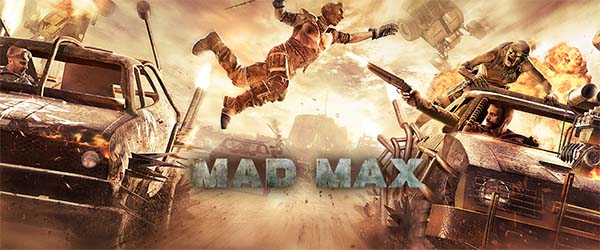
Normally, I try not to get excited about movie-tie in games. They have a very bad track record - with only a handful of exceptions. But this Mad Max game wasn't a direct movie adaptation, and it didn't release simultaneously with the movie, implying that it hopefully wasn't being rushed out the door to meet the movie's release. Warner Brothers Interactive had previously released Middle Earth: Shadow of Mordor, which was also sort of a tie-in to the Lord of the Rings and Hobbit movies, and that game was actually very exceptional! It had a novel and innovative concept around which the entire game revolved (making it very focused), and it was a very well-polished game that was immensely comfortable to control. So Warner Bros had earned some benefit of the doubt for its next game. I wasn't expecting Mad Max to match (let alone exceed) Shadow of Mordor, but I still had hopes that this one would turn out to be a well-realized game that could stand tall and proud as one of those rare, good movie tie-in games. After all, the concept of an open-world, post-apocalyptic action game about smashing spiky, nitrous-fueled cars into each certainly sounds like a solid premise for a game!
Well, not quite...
Wasteland chaos
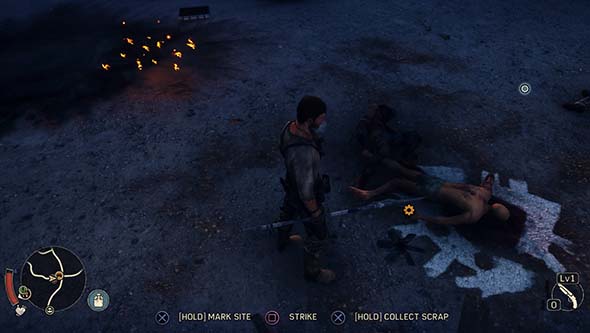
Many actions are overloaded to the X button - the game even displays conflicting prompts at times!
Virtually every interaction that I had with the game was either naggingly uncomfortable in some way or was prone to glitches. Even the basics of moving around and interacting with objects in the game world was a constant chore. When one button does everything; it does nothing (see my Assassin's Creed III review). Fortunately, a couple really important functions (like getting in and out of cars) were mapped to different buttons, but virtually everything else uses the X button. So if you're standing in front of a ladder and holding a weapon, it's a crapshoot whether the game will decide to let you climb the ladder or make you drop the weapon, and then it'll be a crap shoot whether the game lets you pick up the weapon again. Oh there's button-prompts to tell you what you can and can't do, but sometimes they outright conflict with one another. Besides, when you're running or fighting, then you're reacting on impulse and muscle memory rather than reading screen prompts. It doesn't help that the character's movement is very fidgety, so it's hard to position yourself properly when trying to interact with objects. I think the developers recognized this, which is probably why they make you have to hold the button for a second in order to perform most actions - to give you time to ask yourself "are you sure this is the action you want to do?".
Not enough space for vehicular combat
Clunky movement isn't limited to walking on foot. Steering vehicles is also very fidgety and floaty, and I found it very difficult to perform any precision maneuvering in the cars. The cars all tend to understeer at high speeds, but then strangely oversteer or fish-tail whenever you let off the gas. Trying to hit a ramp or knock down an enemy scarecrow or ram a sniper tower would often require multiple passes in order to succeed, and doing slaloms through the canyons resulted in a lot of cheap impacts. The rough terrain also leads to a lot of spin-outs. The vehicles feel so weightless and floaty that they can park on nearly vertical slopes, and running over a pebble can send the car hurtling and flipping 20 feet in the air. On a more personal note, I prefer my driving games to have cameras very close to the action, and so Mad Max's driving camera feels like it's a mile away from the action, which makes it harder for me to get a feel for precisely where the car is in relation to the environment. Virtually none of the game's vehicular set pieces really worked all that well for me due to these nagging control and scaling issues. If the map were bigger to accommodate multiple vehicles running side-by-side on a road, then dealing with the low-traction sand or the unlevel rocks wouldn't be so much of a consistent problem. Even having the option to zoom in the camera (an option that I couldn't find) would go along way towards helping me make more precise maneuvers.
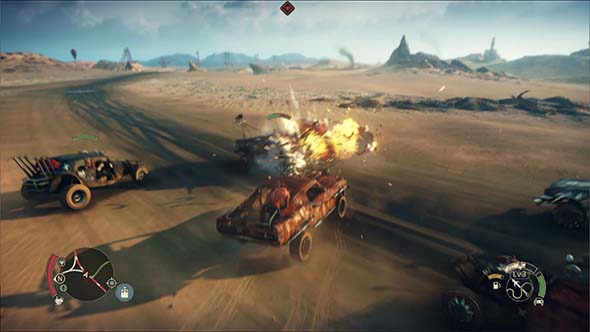
The primary gimmick of vehicular combat works fairly well in spite of the map not feeling big enough to support it.
This game really lives or dies based on how well the cars perform. The bulk of the game is played from within your car. You use the car to travel the world, and it's actually your primary weapon thanks to the game's novel vehicular combat. This vehicular combat would actually be really fun if the cars handled a bit better and were durable enough to actually take the beating that the combat entails... [More]
0acf283b-cb76-4ee2-80ba-14aaf6805d1e|0|.0
Tags:Mad Max, Max, Warner Brothers Interactive Entertainment, Avalanche Studios, vehicle, car, driving, combat, gasoline, water, wasteland, open world, sandbox, action, survival, fuel, food, post-apocalypse, nuclear war, Australia, Max Rockatansky, Chumbucket, Mad Max: Fury Road, movie tie-in, Achievement unlocked
|

| 12 | | | | | | | 60 | | 11 | | | | | | | 55 | | 10 | | | | | | | 50 | | 09 | | | | | | | 45 | | 08 | | | | | | | 40 | | 07 | | | | | | | 35 | | 06 | | | | | | | 30 | | 05 | | | | | | | 25 | | 04 | | | | | | | 20 | | 03 | | | | | | | 15 | | 02 | | | | | | | 10 | | 01 | | | | | | | 05 |
|